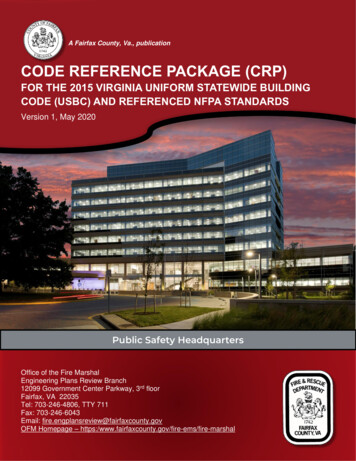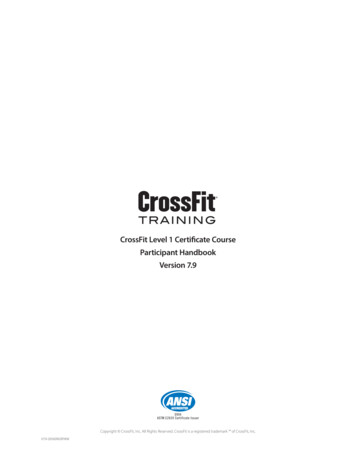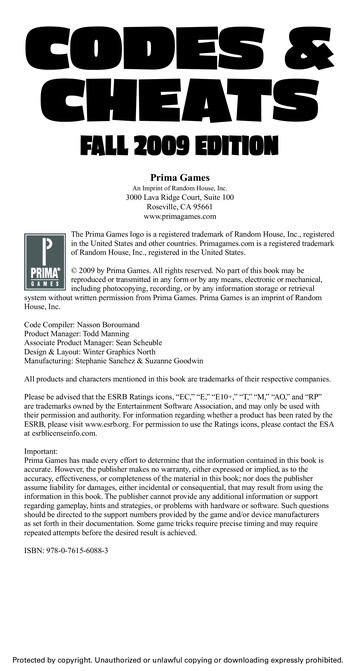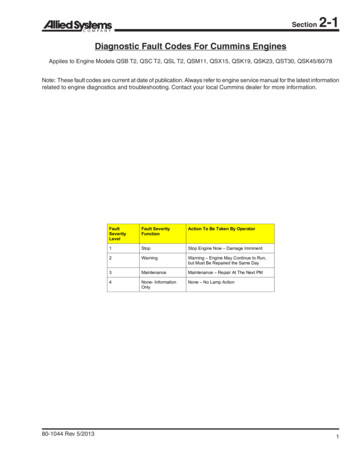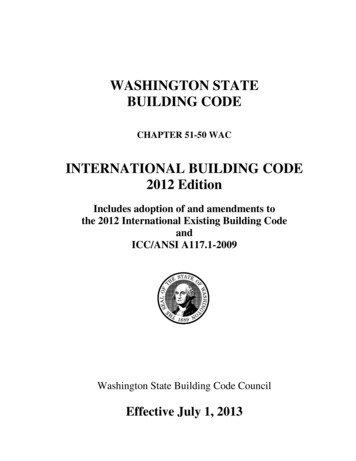
Transcription
CambridgeInternational A and AS Level MathematicsPure Mathematics 1Sophie GoldieSeries Editor: Roger Porkessi7 EDUCATIONHODDERAN HACHETTE UK COMPANYwww.ebook3000.com
Questions from the Cambridge International Examinations A & AS level Mathematics papersare reproduced by permission of University of Cambridge International Examinations.Questions from the MEI A & AS level Mathematics papers are reproduced by permission of OCR.We are grateful to the following companies, institutions and individuals you have given permissionto reproduce photographs in this book.page 106, Jack Sullivan/ Alamy; page 167, RTimages/Fotolia; page 254, Hunta/Fotolia;page 258, Olga Iermolaieva/ FotoliaEvery effort has been made to trace and acknowledge ownership of copyright. The publishers will beglad to make suitable arrangements with any copyright holders whom it has not been possible to contact.Hachette UK's policy is to use papers that are natural, renewable and recyclable products andmade from wood grown in sustainable forests. The logging and manufacturing processes areexpected to conform to the environmental regulations of the country of origin.Orders: please contact Bookpoint Ltd, 130 Milton Park, Abingdon, Oxon OX14 4SB.Telephone: (44) 01235 827720. Fax: (44) 01235 400454. Lines are open 9.00-5.00, Mondayto Saturday, with a 24-hour message answering service. Visit our website at www.hoddereducation.co.ukMuch of the material in this book was published originally as part of the MEI StructuredMathematics series. It has been carefully adapted for the Cambridge International A & AS levelMathematics syllabus.The original ME! author team for Pure Mathematics comprised Catherine Berry, Bob Francis,Val Hanrahan, Terry Heard, David Martin, Jean Matthews, Bernard Murphy, Roger Porkess and Peter Seeker. ME!, 2012First published in 2012 byHodder Education, a Hachette UK company,338 Euston RoadLondon NW! 3BHImpression numberYear54 32 I2016 2015 2014 2013 2012All rights reserved. Apart from any use permitted under UK copyright law, no part of thispublication may be reproduced or transmitted in any form or by any means, electronic ormechanical, including photocopying and recording, or held within any information storageand retrieval system, without permission in writing from the publisher or under licence fromthe Copyright Licensing Agency Limited. Further details of such licences (for reprographicreproduction) may be obtained from the Copyright Licensing Agency Limited, SaffronHouse, 6-10 Kirby Street, London ECIN 8TS.Cover photo by Joy Fera/FotoliaIllustrations by Pantek Media, Maidstone, KentTypeset in IO.Spt Minion by Pantek Media, Maidstone, KentPrinted in DubaiA catalogue record for this title is available from the British LibraryISBN 978 1444 14644 8www.ebook3000.com
ContentsChapter 1Key to symbols in this bookviIntroductionviiThe Cambridge A & AS Level Mathematics 9709 o-ordinate geometry38Co-ordinatesThe intersection of a line and a curve38393941424649566370Sequences and series75Definitions and notation76778495Background algebraLinear equationsChanging the subject of a formulaQuadratic equationsSolving quadratic equationsEquations that cannot be factorisedThe graphs of quadratic functionsThe quadratic formulaSimultaneous equationsChapter 2Plotting, sketching and drawingThe gradient of a lineThe distance between two pointsThe mid-point of a line joining two pointsThe equation of a straight lineFinding the equation of a lineThe intersection of two linesDrawing curvesChapter 31Arithmetic progressionsGeometric progressionsBinomial expansions
Chapter 4Chapter 5Chapter 6Chapter 7Functions106The language of functions106Composite functions112Inverse functions115Differentiation123The gradient of a curve123Finding the gradient of a curve124Finding the gradient from first principles126Differentiating by using standard results131Using differentiation134Tangents and normals140Maximum and minimum points146Increasing and decreasing functions150Points of inflection153The second derivative154Applications160The chain rule167Integration173Reversing differentiation173Finding the area under a curve179Area as the limit of a sum182Areas below the x axis193The area between two curves197The area between a curve and the y axis202The reverse chain rule203Improper integrals206Finding volumes by integration208Trigonometry216Trigonometry background216Trigonometrical functions217Trigonometrical functions for angles of any size222The sine and cosine graphs226The tangent graph228Solving equations using graphs of trigonometrical functions229Circular measure235The length of an arc of a circle239The area of a sector of a circle239Other trigonometrical functions244
Chapter 8The angle between two tors in two dimensionsVectors in three dimensionsVector calculations
Key to symbols in this book0This symbol means that you want to discuss a point with your teacher. If you areworking on your own there are answers in the back of the book. It is important,however, that you have a go at answering the questions before looking up theanswers if you are to understand the mathematics fully.This symbol invites you to join in a discussion about proof. The answers to thesequestions are given in the back of the book.This is a warning sign. It is used where a common mistake, misunderstanding ortricky point is being described.This is the ICT icon. It indicates where you could use a graphic calculator or acomputer. Graphical calculators and computers are not permitted in any of theexaminations for the Cambridge International A & AS Level Mathematics 9709syllabus, however, so these activities are optional.This symbol and a dotted line down the right-hand side of the page indicatesmaterial that you are likely to have met before. You need to be familiar with thematerial before you move on to develop it further.eThis symbol and a dotted line down the right-hand side of the page indicatesmaterial which is beyond the syllabus for the unit but which is included forcompleteness.
IntroductionThis is the first of a series of books for the University of Cambridge InternationalExaminations syllabus for Cambridge International A & AS Level Mathematics9709. The eight chapters of this book cover the pure mathematics in AS level. Theseries also contains a more advanced book for pure mathematics and one eachfor mechanics and statistics.These books are based on the highly successful series for the Mathematics inEducation and Industry (MEI) syllabus in the UK but they have been redesignedfor Cambridge users; where appropriate new material has been written and theexercises contain many past Cambridge examination questions. An overview ofthe units making up the Cambridge International A & AS Level Mathematics9709 syllabus is given in the diagram on the next page.Throughout the series the emphasis is on understanding the mathematics aswell as routine calculations. The various exercises provide plenty of scope forpractising basic techniques; they also contain many typical examination questions.An important feature of this series is the electronic support. There is anaccompanying disc containing two types of Personal Tutor presentation:examination-style questions, in which the solutions are written out, step by step,with an accompanying verbal explanation, and test yourself questions; these aremultiple-choice with explanations of the mistakes that lead to the wrong answersas well as full solutions for the correct ones. In addition, extensive online supportis available via the MEI website, www.mei.org.uk.The books are written on the assumption that students have covered andunderstood the work in the Cambridge IGCSE syllabus. However, some ofthe early material is designed to provide an overlap and this is designated'Background'. There are also places where the books show how the ideas can betaken further or where fundamental underpinning work is explored and suchwork is marked as 'Extension'.The original MEI author team would like to thank Sophie Goldie who has carriedout the extensive task of presenting their work in a suitable form for CambridgeInternational students and for her many original contributions. They would alsolike to thank Cambridge International Examinations for their detailed advice inpreparing the books and for permission to use many past examination questions.Roger PorkessSeries Editor
The Cambridge A & ASLevel Mathematics syllabusCambridgeIGCSEMathematicsALevelMathematic
AlgebraP1Sherlock Holmes: 'Now the skillful workman is very careful indeed. He will have nothing but the tools which may help him in doinghis work, but of these he has a large assortment, and all in the mostperfect order.'A. Conan Doy/eCl) Background algebraManipulating algebraic expressionsYou will often wish to tidy up an expression, or to rearrange it so that it is easierto read its meaning. The following examples show you how to do this. Youshould practise the techniques for yourself on the questions in Exercise lA.Collecting termsVery often you just need to collect like terms together, in this example those in x,those in y and those in z.0EXAMPLE 1. 1What are 'like' and 'unlike' terms?Simplify the expression 2x 4y- Sz- Sx- 9y 2z 4x- 7y 8z.SOLUTIONExpression 2x 4x- Sx 4y- 9y-7y 2z 8z- Sz 6x-5x 4y-16y X-12y Sz.-----{This cannot besimplified furtherand so it is the answer.Removing bracketsSometimes you need to remove brackets before collecting like terms together.
EXAMPLE 1.2Simplify the expression 3(2x- 4y) - 4(x- Sy).SOLUTIONExpression 6x- 12y- 4x 20yEXAMPLE 1.3Notice (--4)x (-5y) 20ySimplify x(x 2)- (x- 4).SOLUTIONExpression x2 2x- x 4 . -------1'-./'----'"-.J' '--""-./EXAMPLE 1.4Simplify a(b c)- ac.SOLUTIONExpression ab ac- ac . -----1'--./'-J'. ,.'-. ./'./FactorisationIt is often possible to rewrite an expression as the product of two or morenumbers or expressions, its factors. This usually involves using brackets andis called factorisation. Factorisation may make an expression easier to use andneater to write, or it may help you to interpret its meaning.EXAMPLE 1.5Factorise 12x- 18y.SOLUTIONExpressionEXAMPLE 1.6 6(2x- 3y)Factorise x2 - 2xy 3xz.SOLUTIONExpression x(x- 2y 3z)
MultiplicationSeveral of the previous examples have involved multiplication of variables: cases likeanda x b abxx x x 2.In the next example the principles are the same but the expressions are not quiteso simple.EXAMPLE 1.7SOLUTIONExpression 3 x 4 x 5 x p 2 x p x q x q 3 x q x r x r2 60 X p3 X q5 X r 3 60p3qsr3FractionsThe rules for working with fractions in algebra are exactly the same as those usedin arithmetic.EXAMPLE 1.8SOLUTIONAs in arithmetic you start by finding the common denominator. For 2, 10 and 4this is 20.Then you write each part as the equivalent fraction with 20 as its denominator,as follows . lOx 4y SzExpression - 2o 20 20lOx- 4y Sz20EXAMPLE 1.9x2 y2Simplify - - -.yXSOLUTION.x3 y3ExpressiOn - - -xyxyx3 y3 ---xybe left out.j
2EXAMPLE 1.105yz. l"fy 3xSImpi - X - .5y 6xSOLUTIONSince the two parts of the expression are multiplied, terms may be cancelled topand bottom as in arithmetic. In this case 3, 5, x and y may all be cancelled.Expression 'Jxr x yz y(jf2;txz2EXAMPLE 1 .11. l"fy (x -1?SImp1 4.x(x ).1SOLUTION(x- 1) is a common factor of both top and bottom, so may be cancelled.However, xis not a factor of the top (the numerator), so may not be cancelled.(X1)2Expression - - - 4xEXAMPLE 1. 12. l"fy 24.x 6SImpI 3(4.x 1)"SOLUTIONWhen the numerator (top) and/or the denominator (bottom) are not factorised,first factorise them as much as possible. Then you can see whether there are anycommon factors which can be cancelled.6(4.x 1).ExpressiOn 3(4.x 1) 2EXERCISE 1A1Simplify the following expressions by collecting like terms.m(ii)8x 3x 4x- 6x3p 3 5p-7-7p-9(iii)2k 3m 8n- 3k- 6m- 5n 2k- m n(iv)2a 3b-4c 4a-5b-8c-6a 2b 12c(v)r- 2s- t 2r- 5t- 6r- 7t- s Ss- 2t 4r
23Factorise the following expressions.lil4x Byliil(iii)72f- 36g- 48h(iv)(vi12P 144km- 72kn12a 15b- 18cp 2 - pq prm)CSimplify the following expressions, factorising the answers where possible.8(3x 2y) 4(x 3y)liil2(3a- 4b Se) - 3(2a- Sb- c)(iii)6(2p- 3q 4r)- 5(2p- 6q- 3r)- 3(p- 4q 2r)lvlw h) 3(21- w- 2h) Sw5u-6(w-v) 2(3u 4w-v)-llu4 Simplify the following expressions, factorising the answers where possible.5lila(b c) a(b- c)(iilk(m n)-m(k n)liiilp(2q r 3s)- pr- s(3p q)(ivlx(x- 2)- x(x- 6) 8(vix(x- 1) 2(x-l)- x(x 1)Perform the following multiplications, simplifying your answers.lil2xy x 3x2yliiilkm x mn x nk(virs X 2stx 3tu X 4ur5a 2bc3 x 2ab 2 x 3clivl 3pq 2rx 6p 2qrx 9pqr2(ii)6 Simplify the following fractions as much as possible.lilabliilac(ivl2e4f2(iii) 5x(iii)E. X 14a2b2ab7Simplify the following as much as possible.(i)(iv)bXQX f.(ii)ac3x2y8yXX3z5z4x22qp2fg X 4gh2 X 32fh34fh12j316hs Write the following as single fractions.lil2 3(iv) 2x -3(ii) 2x5(v) 2::: -423 3x4(iiil 3z8 2z 5z125y 4y859 Write the following as single fractions.(i)l .2.(ii)l l(iv) . !1.q p(v)l l lXXriiii"CDm(ivl 4(1 CDXa(iii)ybc1 Xy24
10Write the following as single fractions.(i)X 1 X4-12)(.IV1 3(2.x5 1) - 7(x211(ii)2(v)2.x3X -15. 3x - 5 x - 7(Ill1 - 4 - -6-4x 1 7x - 3812Simplify the following expressions.( ')I 32.x 6X6x-12X- 2(ivl - --(ii)6(2.x 1)23(2.x 1)5(3x 2?(vl6x(iii)2x( y- 3) 48x 2(y- 3)x L6x 4Cl) Linear equationsf)What is a variable?You will often need to find the value of the variable in an expression in aparticular case, as in the following example.EXAMPLE 1.13A polygon is a closed figure whose sides are straight lines. Figure 1.1 shows aseven-sided polygon (a heptagon).Figure 1.1An expression for So, the sum of the angles of a polygon with n sides, isS 180(n-2).f)How is this expression obtained?Try dividing a polygon into triangles, starting from one vertex.Find the number of sides in a polygon with an angle sum ofm180 liil 1080 .
SOLUTIONmSubstituting 180 forS givesDividing both sides by 180Adding 2 to both sides180 180(n- 2)1 n- 23 nThe polygon has three sides: it is a triangle.liil Substituting 1080 forS givesDividing both sides by 180Adding 2 to both sides1080 180(n- 2)6 n- 28 nThe polygon has eight sides: it is an octagon.Example 1.13 illustrates the process of solving an equation. An equation is formedwhen an expression, in this case 180(n- 2), is set equal to a value, in this case 180 or1080, or to another expression. Solving means finding the value( s) of the variable( s)in the equation.Since both sides of an equation are equal, you may do what you wish to anequation provided that you do exactly the same thing to both sides. If there isonly one variable involved (liken in the above examples), you aim to get thaton one side of the equation, and everything else on the other. The two exampleswhich follow illustrate this.In both of these examples the working is given in full, step by step. In practiceyou would expect to omit some of these lines by tidying up as you went along.0 ALook at the statement 5(x-l) 5x- 5.What happens when you try to solve it as an equation?This is an identity and not an equation. It is true for all values of x.For example, try x 11: 5(x-l) 5 x (11-1) 50; 5x- 5 55- 5 50./,or try x 46: 5(x-1) 5 x (46- 1) 225; 5x- 5 230-5 225 ./,or try x anything else and it will still be true.To distinguish an identity from an equation, the symbol is sometimes used.Thus 5(x- 1) 5x- 5.I"":;·.CDIllCD.o·.ClcIll Cll
P1EXAMPLE 1.14Solve the equation 5(x- 3) 2(x 6).SOLUTION5x- 15 2x 125x-2x-15 2x-2x 123x-15 123x-15 15 12 153x 273x 27 33x 9Open the bracketsSubtract 2x from both sidesTidy upAdd 15 to both sidesTidy up.la.aQ)Cll;a:Divide both sides by 3CHECKWhen the answer is substituted in the original equation both sides should comeout to be equal. If they are different, you have made a mistake.Left-hand sideRight-hand side5(x-3)5(9- 3)2(x 6)2(9 6)2 X 1530(as required).5X630EXAMPLE 1.15Solve the equation (x 6) x (2x- 5).SOLUTIONStart by clearing the fractions. Since the numbers 2 and 3 appear on the bottomline, multiply through by 6 which cancels both of them.6xMultiply both sides by 6TidyupOpen the bracketsSubtract 6x, 4x, and 18from both sidesTidyup6) 6 x x 6 x3(x 6) 6x 2(2x- 5)3x 18 6x 4x-103x-6x-4x -10-18-7x -28-7x -28-7 -7x 4Divide both sides by (-7)CHECKSubstituting x 4 inLeft-hand side6) x Right-hand side 6)102535 (as required).5) gives:5)
EXERCISE 181Solve the following equations.(i)Sa- 32 68(ii)4b- 6 3b 2(iii)2c 12 Se 12S(2d 8) 2(3d 24)(iv)2(v)3(2e-1) 6(e 2) 3e(vi)7(2- f)- 3(f- 4) 10/-4(vii)Sg 2(g- 9) 3(2g- S) 11(viii)3(2h- 6)- 6(h S) 2(4h- 4) -10(h 4)(ix).! k .4! k 362(x)iu-s) (xi)i(3m S) 1i(2m-1) si(xii)n (n 1) i(n 2) (ii)34Write this information in the form of an equation for a, the size in degreesof the smallest angle.Solve the equation and so find the sizes of the three angles.Miriam and Saloma are twins and their sister Rohana is 2 years olderthan them.The total of their ages is 32 years.mWrite this information in the form of an equation for r, Rohana's agein years.(ii)What are the ages of the three girls?The length, d m, of a rectangular field is 40 m greater than the width.The perimeter of the field is 400 m.mWrite this information in the form of an equation for d.liil Solve the equation and so find the area of the field.5Yash can buy three pencils and have 49c change, or he can buy five pencils andhave 1Sc change.(i).:ocCDniii'.CDIllz 11The largest angle of a triangle is six times as big as the smallest. The third angleis 7S 0 (i)mWrite this information as an equation for x, the cost in cents of one pencil.liil How much money did Yash have to start with?lj
P1In a multiple-choice examination of 25 questions, four marks are given foreach correct answer and two marks are deducted for each wrong answer.One mark is deducted for any question which is not attempted.A candidate attempts q questions and gets c correct.678(i)Write down an expression for the candidate's total mark in terms of q and c.(ii)James attempts 22 questions and scores 55 marks. Write down and solvean equation for the number of questions which James gets right.Joe buys 18 kg of potatoes. Some of these are old potatoes at 22c per kilogram,the rest are new ones at 36c per kilogram.(i)Denoting the mass of old potatoes he buys by m kg, write down anexpression for the total cost ofJoe's potatoes.(iilJoe pays with a 5 note and receives 20c change. What mass of newpotatoes does he buy?In 18 years' time Hussein will be five times as old as he was 2 years ago.(ilWrite this information in the form of an equation involving Hussein'spresent age, a years.(ii)How old is Hussein now?41) Changing the subject of a formulaThe area of a trapezium is given bywhere a and b are the lengths of the parallel sides and h is the distance betweenthem (see figure 1.2). An equation like this is often called a formula.bhaFigure 1.2The variable A is called the subject of this formula because it only appears onceon its own on the left-hand side. You often need to make one of the othervariables the subject of a formula. In that case, the steps involved are just thesame as those in solving an equation, as the following examples show.
EXAMPLE 1.16Make a the subject in(a b)h.SOLUTIONIt is usually easiest if you start by arranging the equation so that the variable youwant to be its subject is on the left-hand side.Divide both sides by hSubtract b from both sides .::r(1)Illc 2Aha bCT.i'n2Aa --b :IUlUl(a b) h 2A I»:;·b)h AMultiply both sides by 2(")::r0h.I».0EXAMPLE 1.17Make T the subject in the simple interest formula I ·SOLUTIONPRT IArrange with Ton the left-hand sideEXAMPLE 1.18Multiply both sides by 100 Divide both sides by P and R 100PRT lOOIT lOOIPRMake x the subject in the formula v of an oscillating point.)w.J a2-x 2 (This formula gives the speedSOLUTIONSquare both sides Divide both sides by ro 2 Add x2 to both sides v2Subtract 2 from both sides Take the square root of both sides wEXAMPLE 1.19x Make m the subject of the formula mv I mu. (This formula gives themomentum after an impulse.)SOLUTIONCollect terms in m on the left-hand sideand terms without m on the other. Factorise the left-hand sideDivide both sides by ( v- u) mv- mu Im(v-u) Im Iv-u3cii'
EXERCISE 1C1Make lil a (iil t the subject in v u at.2Make h the subject in V l wh.3Make r the subject in A 1t r2 4Make lil s5Make h the subject in A 2rrrh 2rrr2.6Make a the subject in s ut 1at2 7Make b the subject in h -./ a 2 b2 (ii)u the subject in v2 - u2 2as.s Make gthe subject in T 2rr910/f.Make m the subject in E mgh MakeR the subject181mv2 .211Make h the subject in bh 2A - ah.12Make u the subject in f 13Make d the subject in u214Make Vthesubjectinp 1 VM mRT p 2 VM.u v-du fd 0.All the formulae in Exercise lC refer to real situations. Can you recognise them?Quadratic equationsEXAMPLE 1.20The length of a rectangular field is 40 m greater than its width, and its area is6000 m 2 Form an equation involving the length, x m, of the field.SOLUTIONSince the length of the field is 40 m greater than the width,the width in m must be x- 40and the area in m 2 is x(x- 40).x-40So the required equation is x(x- 40) 6000Xorx2 -40x- 6000 0.Figure 1.3
This equation, involving terms in x 2 and x as well as a constant term (i.e. anumber, in this case 6000), is an example of a quadratic equation. This is incontrast to a linear equation. A linear equation in the variable x involves onlyterms in x and constant terms.P1It is usual to write a quadratic equation with the right-hand side equal to zero.0cTo solve it, you first factorise the left-hand side if possible, and this requires aparticular technique.Ill.IllCl.c;·(1).c;·J:lcIll. Quadratic factorisationEXAMPLE 1.21Factorise xa xb ya yb.SOLUTIONxa xb ya yb x (a b) y (a b)\;{ (x y)(a b)The expression is now in the form of two factors, (x y) and (a b), so this is theanswer.You can see this result in terms of the area of the rectangle in figure 1.4. This canbe written as the product of its length (x y) and its width (a b), or as thesum of the areas of the four smaller rectangles, xa, xb, ya and yb.XyaxayabxbybFigure 1.4The same pattern is used for quadratic factorisation, but first you need to splitthe middle term into two parts. This gives you four terms, which correspond tothe areas of the four regions in a diagram like figure 1.4.
EXAMPLE 1.22Factorise x 2 7x 12.SOLUTIONSplitting the middle term, 7x, as 4x 3x you havex 2 7x 12 x 2 4x 3x 12 x(x 4) 3(x 4) (x 3)(x 4).How do you know to split the middle term, 7x, into 4x 3x, rather than say5x 2x or 9x- 2x?3X3xX44x12Figure 1.5The numbers 4 and 3 can be added to give 7 (the middle coefficient) andmultiplied to give 12 (the constant term), so these are the numbers chosen.EXAMPLE 1.23Factorise x 2 - 2x- 24.SOLUTIONFirst you look for two numbers that can be added to give -2 and multiplied togive-24:-6 4 -2-6 X ( 4) -24.The numbers are -6 and 4 and so the middle term, -2x, is split into -6x 4x.x 2 - 2x- 24 x 2 - 6x 4x- 24 x(x- 6) 4(x- 6) (x 4)(x-6).
This example raises a number of important points.makes no difference if you write 4x- 6x instead of- 6x 4x. In that casethe factorisation reads:1 Itx 2 - 2x- 24 x 2 4x- 6x- 24 x(x 4)- 6(x 4) (x- 6)(x 4)230cmThere are other methods of quadratic factorisation. If you have already learnedanother way, and consistently get your answers right, then continue to use it.This method has one major advantage: it is self-checking. In the last line butone of the solution to the example, you will see that (x 4) appears twice. If atthis point the contents of the two brackets are different, for example (x 4) and(x- 4), then something is wrong. You may have chosen the wrong numbers, ormade a careless mistake, or perhaps the expression cannot be factorised. Thereis no point in proceeding until you have sorted out why they are different.You may check your final answer by multiplying it out to get back to theoriginal expression. There are two common ways of setting this out.(i)Long multiplicationx 4This isx(x 4).x 2 4x-6x- 242x -2x- 24 (as required)This is - 6(x 4).(iil Multiplying term by term(x 4) ( x- 6) x 2 - 6x 4x- 24 x 2 - 2x- 24(as required)You would not expect to draw the lines and arrows in your answers. Theyhave been put in to help you understand where the terms have come from.EXAMPLE 1.24Factorise x 2 - 20x 100.SOLUTIONx 2 - 20x 100 x 2 - 10x- 10x 100 x(x- 10)- lO(x- 10) (x- 10)(x-10) (x-10)2ar;·Q.(clearly the same answer).Notice:(- 10) (-10) -20(- 10) X (- 10) 100.QcI»c;· COl
NoteThe expression in Example 1.24 was a perfect square. lt is helpful to be able to recognise the form of such expressions.(x a) 2 x 2 2ax a 2(x- a) 2 x 2-(in this case a 10)2ax a 2Factorise x 2 - 49.EXAMPLE 1.25x 2 - 49 can be written as x 2 Ox- 49.x 2 Ox- 49 x 2 - 7x 7x- 49 x(x- 7) 7(x- 7) (x 7)(x-7)NoteThe expression in Example 1.25 was an example of the difference of two squareswhich may be written in more general form asa2G-tJ2 (a b)( a- b).What would help you to remember the general results from Examples 1.24and 1.25?The previous examples have all started with the term x 2 , that is the coefficient ofx 2 has been 1. This is not the case in the next example.EXAMPLE 1.26Factorise 6x2 x-12.SOLUTIONThe technique for finding how to split the middle term is now adjusted. Start bymultiplying the two outside numbers together:6x(-12) -72.Now look for two numbers which add to give 1 (the coefficient of x) andmultiply to give -72 (the number found above) .( 9)( 9) (-8) 1X(-8) -72Splitting the middle term gives6x2 9x- Sx-12 3x(2x 3)- 4(2x 3) (3x- 4)(2x 3)-4 is a factor of both- 8x and - 12.
NoteThe method used in the earlier examples is really the same as this. it is just that inthose cases the coefficient of x 2 was 1 and so multiplying the constant term by it hadno effect.en0 :rAIQBefore starting the procedure for factorising a quadratic, you should always checkthat the terms do not have a common factor as for example in2x2-8x 6.cc.ri".o·I»c.I»CDThis can be written as 2( x 2 - 4x 3) and factorised to give 2( x- 3) (x- 1).ccI»:IUlSolving quadratic equationsIt is a simple matter to solve a quadratic equation once the quadratic expressionhas been factorised. Since the product of the two factors is zero, it follows thatone or other of them must equal zero, and this gives the solution.EXAMPLE 1.27Solve x2 - 40x- 6000 0.SOLUTION x 2 - 40x- 6000 (x 60)(x- lOO) either x 60 or x- 100 x 2 - lOOx 60x- 6000x(x- 100) 60(x-100)(x 60)(x- 100)00 x -600 x 100The solution is x -60 or 100 . .QLook back to page 12.What is the length of the field?NoteThe solution of the equation in the example is x -60 or 100.The roots of the equation are the values of x which satisfy the equation, in this caseone root is x -60 and the other root is x 100.Sometimes an equation can be rewritten as a quadratic and then solved.EXAMPLE 1.28Solve x 4 - 13x2 36 0SOLUTIONThis is a quartic equation (its highest power of xis 4) and it isn't easy to factorisethis directly. However, you can rewrite the equation as a quadratic in x2.
Let y x 2P1x 4 - 13x2 36 0(x2 ) 2 - 13x2 36 0 - - - - - 1y2 -13y 36 0Now you have a quadratic equation which you can factorise.(y- 4)(y- 9) 0Soy 4 or y 9Since y x 2 then x 2 4x 22or x 9x 3You may have to do some work rearranging the equation before you can solve it.EXAMPLE 1.29Find the real roots of the equation x 2 - 2 82 XSOLUTIONYou need to rearrange the equation before you can solve it.x 2 - 2 §xzMultiply by il-:Rearrange:2x2 82x2 - 8 0x4x4 --This is a quadratic in x 2 You can factorise it directly, without substituting in for x 2 (x2 2)(x2 -4) 0So this quartic equationonly has two real roots . Youcan find out more about rootswhich are not real in P3.So x 2 -2 which has no real solutions.or x 2 4 x 2EXERCISE 1012Factorise the following expressions.(i)al am bl bm(ii)px py- qx- qy(iii)ur- vr us- vs(iv)m 2 mn pm pn(v)x 2 - 3x 2x- 6(vi)y 2 3y 7y 21(vii)z 2 - 5z 5z- 25(viii)q2 - 3q- 3q 9(ix)2x2 2x 3x 3(x)6v 2 3v-20v-10Multiply out the following expressions and collect like terms.(i)(a 2)(a 3)(ii)(b 5)(b 7)(iii)(c- 4)(c- 2)(iv)(d-5)(d-4)(v)(e 6)(e-l)(vi)(g- 3)(g 3)(vii)(h 5)2(viii)(2i - 3)2(ix)(a b)(c d)(x)(x y)(x- y)
3 Factorise the following quadratic expressions.x 2 6x 8(iii) y 2 9y 20(v)r 2 -2r-15(vii) x 2 - 5x- 6(ix) a 2 -9(i)x 2 - 6x 8r 2 2r- 15s2 - 4s 4(iil(iv)(vi)(viii)(x)x 2 2x 1(x 3) 2 - 9m cCDri.iii'CD4 Factorise the following expressions.22x (iii) 5x 2 (vi2x2 (vii) 6x 2 -(i)(ix)tl5x 2llx 214x 245x- 62- t 22cliil2x2 - 5x 2(ivl 5x2 - llx 2(vi) 4x2 - 49(viiil 9x2 - 6x 1(x)2x2 - 11xy 5f5 Solve the following equations.lil(iiil(v)6x 2 - llx 24 0x 2 - llx 18 0x 2 - 64 0(iilx 2 llx 24 0(iv)x 2 - 6x 9 0Solve the following equations.3x2 - 5x 2 0liiil 3x2 - 5x- 2 02(v) 9x -12x 4 0mliil 3x2 5x 2 0(ivl 25x2 - 16 07 Solve the following equations.lilx 2 - x 20liiilx 2 4 4x3x2 5x 4315(iv) 2x 1 (v)6X -1 -(vi)liilXX3x 14s Solve the following equations.x 4 - 5x2 4 0liiil 9x4 - 13x2 4 0m(v)25x(vii) x 6 -4- 4x 29x 3 0 8 0(ivlx 4 -10x2 9 04x4 - 25x2 36 0(vi)x-(viii)x-(iil6Fx 5 0Fx - 6 09 Find the real roots of the following equations.liil(iv)(vi)12x21 ! - 20 0x2 x4x2 1 x 3 1 3x37. , 2 3(VIII Fx pa
Mathematics series. It has been carefully adapted for the Cambridge International A & AS level Mathematics syllabus. The original ME! author team for Pure Mathematics comprised Catherine Berry, Bob Francis, Val Hanrahan, Terry Heard, David Martin, Jean Matthews, Bernard Murphy, Roger Porkes




